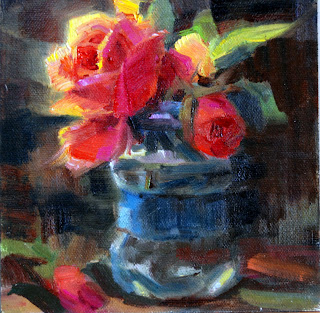
Renoir Copy (Detail)
7x5in oil on canvas board $90.
Pierre-Auguste Renoir (1841-1919) painted Madame Georges Charpentier and her Children in 1878.It is at the Metropolitan Museum, N.Y.
My detail can be seen on the top right of this large painting. I can remember looking at the painting and being totally drawn to the still life portion...and the dog. As the painting is about 5' tall and over 6' wide, that dog is pretty close to being life sized.
When he painted this piece Renoir was at the stage of dissolved outlines, so this may look pretty fuzzy to you, but it holds a lot of appeal for me. I am pretty sure he must have used a round brush as it was the only way I could capture some of those nuances of light and shadow. His color was beautifully luminous and his brushwork, skillfully varied. Renoir painted quite a few roses but this one attracted me as it is different from the previous techniques I have copied.
Renoir spent the last twenty years in a wheelchair, crippled by his arthritis. This required him to develop new painting methods, which he did successfully, but he did require an assistant to place the brush in his hand each day. Amazing...the artistic drive.




























